    
The JUNODS
Alfred Junod (1884–1895)
Junod Société (1888–1890)
Alfred Junod & Cie
Mnemonic: alf-jul-jacc--paul-cal-jacc-90-96-16-34-AO
André Junod
Arthur Philippe Junod (*1864 , †1904, 1888)
Arthur Junod-Turin (1894/1895–1899)
César Aubert (1896–1898)
Firma „JAC“® (Junod, Aubert & Cie)
(Mnemonic for Arthur Ph. Junod und JAC: JArP-64-04-jac-aub88
Félix Junod (Vater von Arthur Philippe)
Mnemonic: fel3595-jul-jacc-paul-cal-jacc-90-96-16-34-AO
Félix Junod-Cuendet (?–?)
Louis Junod (Berlin)
Junod Frères (Edouard-Eugène and Charles-Louis Junod, 1890–1908)
(Mnemonic JuFrEECL9008)
Samuel Junod (1800s–1830)
Samuel Junod [II] (~1852, La Sagne, music box manufacturer)
.jpg)

Stamped on the bedplate: Please, click here
The inventions or designations of the products of the JUNODS
„Cartel-Werke a der Jura-Region“
Alexandra (a), Alexandra (b) (Alfred Junod)
Completaria (Arthur Junod and Cesar Aubert)
Duplex (a), Duplex (b) (Alfred Junod)
Helicoidales System (Arthur Junod and Cesar Aubert)
Helicoidales Patent (Vertrag mit Bornand)
Helvetia (Junod-Aubert & Cie)
Interchangeable (Completaria) (Arthur Junod and Cesar Aubert)
Interchangeable (Alexandra) (Alfred Junod)
Jurassien (a), Jurassien (b) (Junod-Aubert & Cie)
MUSIQUE ORDINAIRE (Arthur Junod-Turin)
Perforated plates (Vertrag mit Mermod)
Orphea (a), Orphea (b), Orphea (c) (Alfred Junod)
Symplicitas (Arthur Junod-Turin)

Cartel-Spieldosen von Junod ( ) )
Music boxes / Spieldosen mit zunächst einmal 5 bekannten Designs von Musiktafeln, weitere könnten noch folgen
Featured composers chapter 2/3 ( ) and chapter 4/4 ( ) and chapter 4/4 ( ) Spielwerke ) Spielwerke
Junod stand in engem (verwandtschaftlichem) Kontakt zu Cuendet und Mermod. Seine Mutter Rosa Cuendet stammte aus l´Auberson. Junod Neffe war Jules Cuendet, und beide halfen einander öfters gegenseitig aus (TMB 16, 8, 1994, S. 237)
Zur Gesamtzahl der Musiktafeln die von Junod verwendet wurden
1.) Musiktafeln mit Porträts von (2) Komponisten:orphea
Nr. 2/3: •Mo – Ver•

 Spielwerke:
8377,
25855,
26999,
30547,
31430,
67501, Spielwerke:
8377,
25855,
26999,
30547,
31430,
67501,
2.) Musiktafeln mit (4 kleinen) Porträts:
Nr.
4/4: •BelMeyer – MoVer•
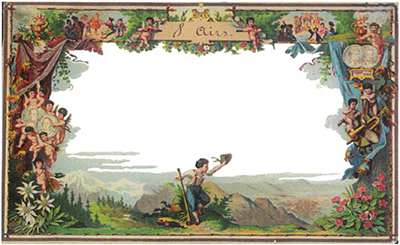
„Waving Shepard“, Bellamy, Tunesheets, 2022, Fig-25-2, attrib. to Arthur Junod
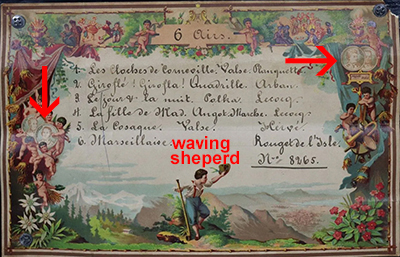


 Spielwerke (bitte durchklicken) Spielwerke (bitte durchklicken)
3.) Rousseau-Insel-Musiktafeln
Cartes de musique „Île Rousseau“
Isle Rousseau tune sheets
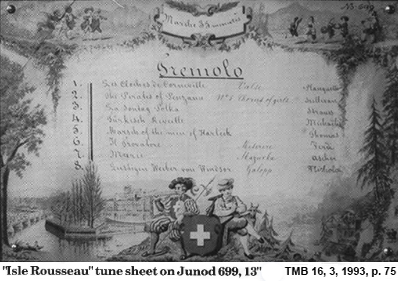
Das Île Rousseau ist eine Insel und Park in Genf, in der Mitte des Rhone, die gerade vom Genfer See abgeflossen ist.
Auf der Insel steht eine Statue von Rousseau, die der Insel den Namen gab
Île Rousseau tune sheets for Junod
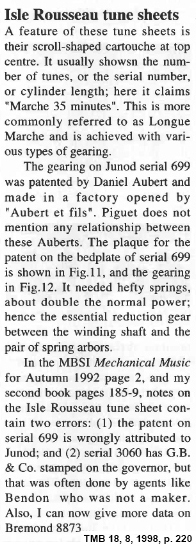
Île Rousseau tune sheets by Bremond

Vergleiche dazu die Ansichten von Genf
4.) Auch die (oder zumindest ein Teil) der auf der linken Seite sind der Firma Junod zuzuordnen
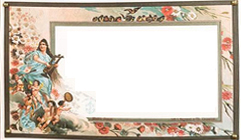
( Spielwerke / movements) Spielwerke / movements)
5.) Lyras links und rechts sowie unten mittig
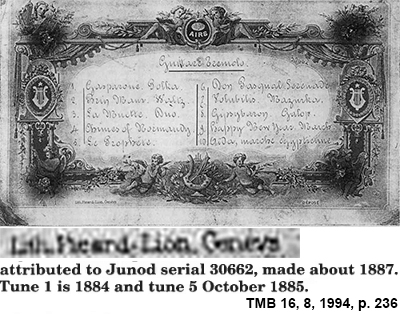
Link zu Picard-Lion
https://www.vincentfreemanantiques.com/cylinder-music-box/junod
Zu der nach Junods Vorbild konstruierten Columbia (1890) von Paillard
Alfred Junod (Sainte-Croix, 1884–1888)
U. S. Patents of Junod, Alfred, Ste. Croix: 356,251, Jan. 18, 1887 – assigned to M. J. Paillard & Co., N. Y. C. Co-patentee: 445,699, Feb. 3, 1891 – assigned to Alfred Junod & Co., Ste. Croix, Switzerland. Switzerland, 2, 293, June 9, 1890. (Mosoriak p. 93)
Inventor of the Duplex system (1887),
Alexandra boxes with interchangeable cylinders operating according to the mandrel principle, [PICT]
as well as the Orphea model (USA)
“In the Sainte-Croix region, Alfred Junod was one of the most imaginative music box manufacturers ever. We owe him the development of music boxes with the Duplex system, the Alexandra boxes with interchangeable cylinders operating according to the mandrel principle, as well as the Orphea model distributed in the United States.” (Piguet 2004, p. 238)
“Alfred Junod set up his company on 24th December 1884 in Sainte-Croix, in the Rue des Lilas 9, which was also the home of Louis Sègalini, an ingenious worker who developed many improvements for music boxes. During those early years, Alfred developed a new music box system which he patented in several countries and in the United States in 1887. This system was baptized Duplex for the simple reason that it had a double set of cylinders and combs tuned the same way, playing the same melody together.” (Piguet 2004, p. 238)
“Junod made several variations on the Duplex system, as did other manufacturers such as Paillard and Mermod Frères. The first model had cylinders and their respective combs mounted in parallel one behind the other. The second, which was more rare, played two cylinders in line, with the governor assembly in between. According to Ord-Hume, these boxes had a spectacular mechanism which gave them a powerful sound, however at the cost of musical quality. This perhaps explained why they were not a commercial success.”
(Piguet 2004, p. 238)
„Junod, Alfred, Ste-Croix, Switzerland, c. 1887. A clever musical-box maker of good quality who devised the Duplex musical box which played two cylinders at once on two combs mounted in parallel. Also made large boxes with spring motor and escapement mounted entirely beneath the bedplate.“
(Ord-Hume, Music Box, 1980, p. 310)
The Junod company
Junod Société
(1888–1890)
“In 1888, about ten years of investigation, the Swiss government passed a law on inventors patent, which the industrial leaders of the country had been claiming vigorously for some time, to begin with, by Nestlé whose petition was signed by many Sainte-Croix music box manufacturers. During the first two years of activity of the federal bureau, many manufacturers applied for patents in order to protect the inventions of the previous years. Alfred Junod was one of them.” (Piguet 2004, p. 239)
Junod, Société. This was the association formed by
•Alfred Junod,
•Jules Jaccard and
•Paul Calame-Jaccard
for the design and manufacture of musical boxes.
They patented a new style of cylinder box using a motor and endless assembly mounted under the bedplate. This was covered by US patent 445699 (3 February 1891), British patent number 12170 (2 August 1890) and French patent 207352. These boxes usually had a repoussé-type silver cartouche in the lid bearing the serial number of the box, and the mechanism was handle-wound from the right side.“
(Ord-Hume, Music Box, 1980, p. 310-311)

Please, click here
Alfred Junod & Cie., a partnership with Jules Jaccard and Paul Calame-Jaccard (1890–1896)
U. S. Patents of Junod, Alfred, Ste. Croix: 356,251, Jan. 18, 1887 – assigned to M. J. Paillard & Co., N. Y. C. Co-patentee: 445,699, Feb. 3, 1891 – assigned to Alfred Junod & Co., Ste. Croix, Switzerland. Switzerland, 2, 293, June 9, 1890. (Mosoriak p. 93)
Alfred Junod 1896–1916/1934
Mnemonic: alf-jul-jacc-paul-cal-jacc-90-96-16-34-AO
“The adoption of this law and the hopes it raised, as well as the inventiveness of which Junod and various other particularly imaginative people of Sainte-Croix were capable, encouraged him to create a company on 28th June 1890. Its objective was ‘to register patents for the manufacture of music boxes’. It was called Alfred Junod & Cie., a partnership with Jules Jaccard and Paul Calame-Jaccard.” (Piguet 2004, p. 239)
Alexandra
“Over the next three years, the three partners invented a system which was more original than the Duplex and which met the demands of the moment more efficiently. The disc boxes had been on the market for five years and represented dangerous competition for the large cylinder boxes because of the moderate price of the spare discs and the easy access to tunes in fashion. They therefore invented an ingenious interchangeable cylinder mechanism, which was moreover inexpensive: they called it the Alexandra.” (Piguet 2004, p. 239)
“The musical movement was provided by a beautifully polished mandrel on which the removeable cylinders slid like a sleeve on an arm. The pins were placed on the cylinder surface and did not come out on the inside. The absence of cement was compensated by a telescopic mandrel. These music boxes were produced in three different sizes, always with zither and tune sheet. The sound quality, however, was considered relatively weak.” (Piguet 2004, p. 239)
“When they first started up their activity, the three associates developed a variation of the Alexandra, an interchangeable cylinder box in the shape of a ‘U’.” (Piguet 2004, p. 239)
Orphea
“In 1890, the Alfred Junod company also brought out a music box which was unique, it had the advantage of minimizing the risk of accidents in case of overly [übermäßig] brutal manipulation of the spring motor assembly. The spring barrel and the speed governor, which would sometimes be damaged during transport, were placed under the bedplate. This model was called Orphea for which a patent application was submitted in France, England and the United States. Orpheas were made in the United States and distributed there by retailers, who thus had less repair worries.” (Piguet 2004, p. 239)
“The company created to file patent applications most likely did not produce the desired results. It was a fact that only the Duplex was made by other manufacturers and to our knowledge no other patents were used except by Alfred Junod and his partners. This was undoubtedly also the reason why the partners [Jules Jaccard and Paul Calame-Jaccard] [...] gave up their company on 12th August 1896, leaving Alfred Junod to continue production. The latter´s own company was meanwhile in financial difficulties but in 1895 he managed to pay off all his creditors, with the result that the situation improved.” (Piguet 2004, p. 239)
End: 1916/1934
“Nothing more was heard of Junod as music box manufacturer after 1916 and on 5th July 1934, all activity officially ceased.”(Piguet 2004, p. 239)
TMB 18, 5, 1998, p. 136, Nr. 28; Bellamy, Music Makers of Switzerland, (2015), p. 6
Félix Junod, (La Sagne, ein km südlich von St. Croix)
Mnemonic: fel3595-jul-jacc-paul-cal-jacc-90-96-16-34-AO
From Félix, *1835, †1895, to Arthur Junod
Junod Arthur, Ste. Croix, U. S. Patents: 366,325, July 12, 1887 – assigned to Emile Cuendet, Hoboken, New Jersey; 367,409, Aug. 2, 1887 – assigned to Jacob & Son, New York City. (Mosoriak p. 93)
US-Patent of a André Junod, citizen of Switzerland, Auberson, Switzerland and Jersey City, N.J.: 550,917, Dec. 3, 1895 – assigned to Emile L. Cuendet, Brooklyn, New York; 629,259, July 18, 1899.
(Mosoriak p. 93)
“Between 1860 and 1900, a highly prosperous period for the music box industry, the Junod family´s activities in this particular field were prolific and creative, with Félix and his son Arthur, who he managed to infect with the music box virus.” (Piguet 2004, p. 238)
“Félix Junod-Cuendet, born on 5th August 1835, had three brothers: Salomon, Gustave and Jules; as well as two sisters: Marianne and Julie. He married Rose-Julie Cuendet, sister of Jules Cuendet, manufacturer from L´Auberson, and so the entire family revolved around music boxes. They had ten children, of whom Arthur-Philippe, born on 24th May 1864 and Elise, who would later marry César Aubert.” (Piguet 2004, p. 238)
“Félix Junod-Cuendet lived in La Sagne and was a member of the SIC (Société industrielle et commerciale) from the moment he started working. His music box production began in the late 1860s.” (Piguet 2004, p. 238)
„Junod, Félix, Ste-Croix, Switzerland. A maker of musical boxes c. 1860.“
(Ord-Hume, Music Box, 1980, p. 310)
In 1880, together with his younger brother Jules, Félix participated in the Exhibition of Machine-Tools for the Watchmaking Industry in Geneva
Then he prepared a large music box which he was going to exhibit at the National Exhibition of Zurich in 1883. In the meantime, however, local manufacturers had asked for a representative to be nominated to the jury. The SIC proposed Félix Junod. This proposal was accepted by the organizers and so, for the first time, Félix found himself among the members of the jury who had to examine the products of group 33, i.e. musical instruments. He performed this task with professional competence and impartiality, a fact which was recognized by the jury. He exhibited the box he had made but this could obviously not compete.” (Piguet 2004, p. 238)
“After that, the J. Junod-Cuendet company never again participated in any exhibition and gradually Félix Junod transferred the company to his son Arthur. The latter had lived and breathed in this type of atmosphere ever since he was a little boy. He was undoubtedly very precocious because he applied for this first patent at the age of twenty-two. The company disappeared on 7th September 1895, after the death of its founder, but a new company was already in place from 31st July onwards.” (Piguet 2004, p. 239-240)
Junod-Aubert & Cie
“Arthur Junod and his brother Louis went into partnership with César Aubert to set up a private company under the name of Junod-Aubert & Cie. He was not devoid of resources. He discovered a new improvment to the interchangeable cylinders, for which he submitted a patent application in England on 13th October 1886, followed by others in Germany, in France and in the United States the following year.” (Piguet 2004, p. 238)
Helvetia and Jurassien
“Installed at Rue de l´Industrie 7, the company prospered sufficiently to employ five workers plus a young boy in 1888, and to publish a catalog the following year highlighting the entire product mark, J.A.C., and detailing the entire product range covering most of the large music boxes. The two original products of Junod and Aubert were the Helvetia, an interchangeable cylinder box, repeatable indefinitely, and a simple music box system called the Jurassien.” (Piguet 2004, p. 238)

Please, click here
Helvetia
“In the catalog they published for publicity purposes they only presented these two articles which could be supplied in a complete range of cases and dimensions. As far as the Helvetia was concerned, its main advantage resided in the fact ‘that in order to obtain new cylinders, it is not necessary to return the article to the factory, you simply indicate the serial number of the box and the cylinders which are already in your possession’. (Junod catalog, Aubert & Co., p. 5)”
“This box was available in a ‘semi-rich’ or ‘inlaid’ box, offering many musical styles: ‘ordinary, symphony-zither, drums-bells, piccolo-zither, expressive mandolin, sublime-harmonie or other expressive melomedium’; it could play six to twelve tunes on cylinders of a diameter oscillating between eighteen and twenty-seven lines, with a length between five and half and sixteen inches.” (Piguet 2004, p. 238)
Interessanter Vergleich Junod/Helvetia, Mermod Frères 56428 und Paillard 96988 von Bulleid, Technology
Jurassien
“The Jurassien was a ‘special system of simplified music box which is suitable for fancy objects because it is wound on the side’. This box was also sppplied with cylinders of various sizes, playing musical styles ranging from symphony-zither to baritone-harmonic, complete with a tune sheet and optional parachute (safety check). The company also produced other types of large boxes, for example with drums, bells and even visible castanets. This type was more spectacular and noisy than harmonious. Upon request, boxes could be supplied with singing birds and even orchestras including flutes, drums, bells and castanets.” (Piguet 2004, p. 238)
Louis Jaccard, Berlin
“Junod and Aubert sold their products in Germany in particular, where they had a representative, Louis Jaccard, established in Berlin, Alte Jacobsstrasse 92. The latter welcomed Auguste Baud when he came to Berlin in 1890 for further training in music box repair.” (Piguet 2004, p. 238)
“In 1891, Louis Junod retired from the partnership, which was subsequently modified to Junod et Aubert, but continuing the same activity. Two years later, on 18th October 1893, the company broke up, its liquidation was finalized in 1896.
Cantonal Exhibition Yverdon 1894
For this reason, Junod and Aubert promoted their products separately at the 1894 Cantonal Exhibition organized by the city of Yverdon.” (Piguet 2004, p. 238)
“César Aubert presents several pieces of different sizes, among which a very beautiful box with double cylinder and powerful sound, a so-called harmony-flute box, as well as a musical chalet. Other boxes, of fine workmanship, have bells, drums, flutes, etc.
Mr. Junod-Turin exhibits a superb musical chalet from the Oberland, with duplex movement and containing a most harmonious double cylinder, and also a wonderful collection of fancy objects.” (Le Nouvelliste, February 1895) (Piguet 2004, p. 238)
From there on the two manufacturers went their own way:
Arthur Junod-Turin (1894/1895–1899)
Arthur Junod-Turin developed the heliocoidal system (called symplicitas), but went bankrupt on 28th July 1898.
“In spite of the fact that the patent application for the heliocoidal system – called symplicitas – submitted by Arthur Junod in 1896 brought renewed hope, the latter went bankrupt on 15th June 1896. The bankruptcy was revoked on 11th November of the same year and on 21st January 1899, Junod abandoned music box manufacture.” (Piguet 2004, p. 238)
César Aubert (1896–1898)
“From there on the two manufacturers went their own way, Arthur Junod-Turin created his own company on 31st July 1895 and César-Louis Aubert on 21st January 1896. However, both companies were short-lived as neither manufacturer took the initiative to launch the production competition for the cylinder boxes. César Aubert gave up his company on 28th July 1898 and became an insurance salesman.” (Piguet 2004, p. 238)
Arthur Junod and Cesar Aubert
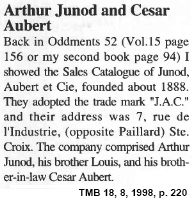
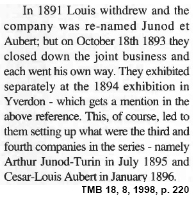

Completaria (interchangeable cylinder box system)
“Arthur Junod was an ardent mechanical music enthusiast and continued to design improvements which he tried to negotiate with local manufacturers. In 1900 and 1901, he discovered a mechanism which controlled strings and flutes activated by a cylinder, a system ‘whose resonance equalled the German disc boxes’ in his opinion, so he filed a Swiss patent and tried to interest major manufacturers, among them Mermod Frères. In the same year, he invented an interchangeable cylinder box system which he called ‘completaria’, meaning complete tune, because it was equipped with a helicoidal movement allowing it to play an unlimited number of bars without forced interruption. He proposed the system to Adalbert Bornand.” (Piguet 2004, p. 238)
André Junod
„Junod, André, Switzerland. Devised a disc-plaing musical box which dispensed with the need for disc projections. Worked for Mermod Frères and was responsible for the designing of the Stella musical box which employed his principle.“
(Ord-Hume, Music Box, 1980, p. 310)
Arthur Philippe Junod, *May 1864 , †Feb. 29th, 1904
Félix Junod und Rosa Cuendet heirateten 1855. Im Mai 1864 kam deren Sohn Arthur auf de Welt.
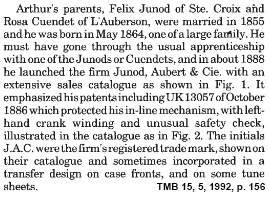
Firma JAC® (Junod, Aubert & Cie) (1888–?)
In den Jahren 1830–1841 war ein (derselbe?) Aubert mit Henry Daniel Capt assoziiert gewesen.
„Cartel-Werke aus der Jura-Region“ (Jurassien)
Spielwerke aus der Produktion von Junod, Aubert & Cie (J.A.C.) wurden nach Paul Bellamy seinerzeit mit dem Begriff „Cartel-Werke aus der Jura-Region“ beworben (Paul Bellamy, DMM 116, 2013, S. 67).
Die 1888 gegründete Firma Junod, Aubert & Cie brachte 1889 den ersten Katalog heraus
Der J.A.C. sales catalogue von 1889 war dreisprachig: Deutsch, Französisch und Englisch.
(Das mechanische Musikinstrument, Nr. 59, 1993, S. 48)
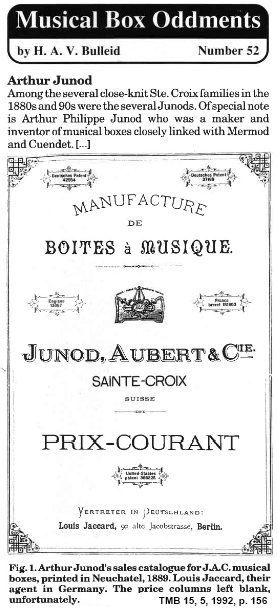
Vertretung in Berlin: Louis Jaccard
Helvetia
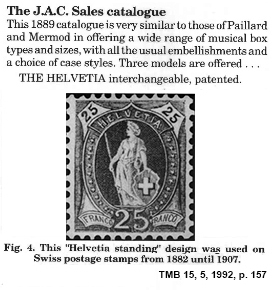
TMB 18, 5, 1998, p. 136, Nr. ebenfalls 29
1889: Heirat mit Anna Turin
1894: Firma Arthur Junod-Turin
Junod bezeichnet sich selbst als Hersteller
`de pièces à musique en tous genres´
bzw. seine Firma Junod-Turin als
„Manufacture de Boȋtes à Musique“

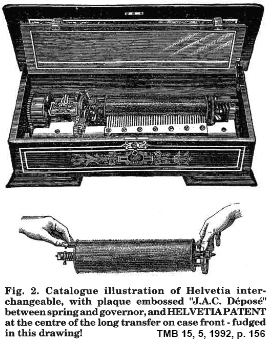
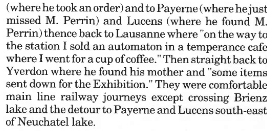
1896: Vertrag mit Bornand über das Helicoidale Patent
1901: Vertrag mit Mermod
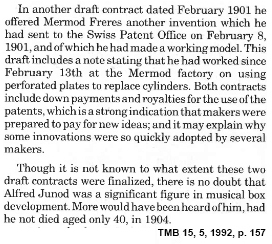
Le Jurassien
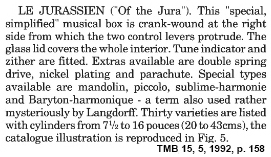
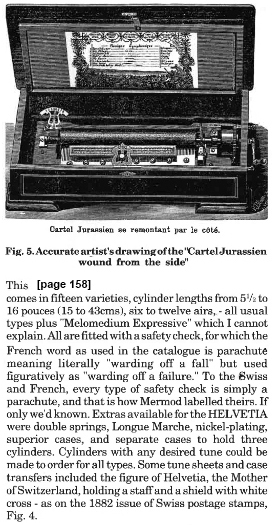
MUSIQUE ORDINAIRE
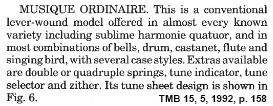

“Arthur Junod fell ill and was no longer able to develop all the projects growing in his agile mind, which were drafted on sheets of paper and which finally took life and sound with the transformation of the metal. On 20th February 1904, he submitted yet another set of documents to Bern for a patent covering an automatic stamp dispenser. He [Arthur Junod] died nine days later [February 29th 1904] in Sainte-Croix at the age of forty.” (Piguet 2004, p. 240-242)
Samuel Junod [I] (1800s–1830)
“Together with the Jaccards, the Junods were among the first music box établisseurs in Sainte-Croix. At the beginning of the nineteenth century, Samuel, Salomn and Isaac Junod joined forces to exploit the know-how they had acquired here and there: Samuel worked for some time with Nicole in Geneva, but left around 1810, during the crisis which hit the city at the end of the lake, and no doubt came back with some musical movements.” (Piguet 2004, p. 238)
“Around 1814-1815, Samuel Junod was one of the first to take an interest in cylinder snuffboxes. He carried on his activity until 1830 and was registered as an établisseur.” (Piguet 2004, p. 238)
Samuel Junod [II] (?–?),
music box manufacturer in La Sagne in 1852
(Piguet 2004, p. 242)
Félix Junod-Cuendet (?–?)
(Piguet 2004, p. 242)
Junod Frères (Edouard-Eugène and Charles-Louis Junod, 1890–1908)
“On 16th June 1890, during the glorious cylinder box years, Edouard-Eugène Junod and Charles-Louis Junod, who lived in L´Auberson, set up a private company under the name Junod Frères.” (Piguet 2004, p. 238)
“Charles Junod-Jaccard was a member of the Société industrielle et commerciale from 1895 onwards. The company was a pillar of the local economy in the 1900s and was one of the twenty-two signatories to the convention adopted in 1902 with the Music Box Workers´ Union, which meant that it produces only small boxes, perhaps even rough movements.” (Piguet 2004, p. 238)
“As a result of the problems it encountered, the company closed down on 21st April 1908.” (Piguet 2004, p. 242)
„Junod Frères, Auberson. Musical-box manufacturers, fl. 1900.“
(Ord-Hume, Music Box, 1980, p. 310)

    
|
.jpg)

























